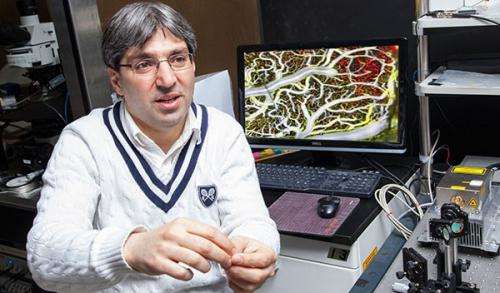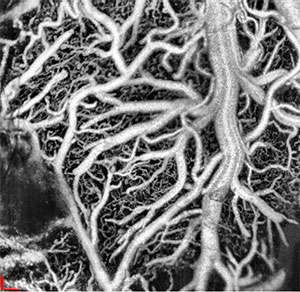Engineer builds device to show how blood flows when we think

A UWM engineer is building a device that could help answer a particularly puzzling biological question – how blood is directed to the brain to power thinking.
Ramin Pashaie, an assistant professor of electrical engineering, received a federal grant to develop technology that will help researchers understand how information processing and blood flow are intertwined. Unraveling the complex brain networks involved in information processing is the first step to understanding the circuitry of diseases like Alzheimer's or atherosclerosis, in which plaque builds up in the arteries.
Here, he explains the project, which is funded by a prestigious Early CAREER grant from the National Science Foundation.
Ultimately, what will this research tell us?
It's very important to know how blood flow and the brain cell activity are correlated. In addition to adding to our understanding of brain functioning, it could help us address other health problems. For example, consider the possibilities in instances of stroke or hypertension when the vascular system changes. We may be able to find a way to compensate when these changes occur, decreasing fatalities.
How much is unknown about this neuron-vascular "coupling"?
For neurons to be able to process information, they need more oxygen and glucose and that means more blood is needed to bring those metabolic products. We can follow blood oxygen levels, but that doesn't always mean the neurons are more active. Evidence points to a more complex system at work – involving multiple variables, including the role of astrocytes.
What are astrocytes?
Besides neurons, there is only one other type of cell in the brain. Astrocytes are "partner cells" to neurons, keeping the tissue intact and regulating neural activity. Astrocytes sit between the neurons and the muscle cells that control the flow of blood. Are astrocytes conductors of this signaling to call for more blood when it's needed? I want to be able to investigate this.

So you are building equipment that will allow you to identify each piece in the process and their roles?
Yes. Armed with these pieces of information – neuron activity, astrocyte activity and the metabolism in each, operating simultaneously – I can then see the entire picture. And I will be able to manipulate each of the elements in this circuit. When you shut down one, what happens?
This sounds really complicated. How can you test all the variables at once in a live specimen?
I am building a hybrid device that incorporates four different kinds of technology, a few of which I have begun to combine with help from various partners, including Justin Williams, a professor of bioengineering at UW-Madison.
One of those processes, called optogenetics, is your specialty. Tell us what that is and how it figures in this work?
We genetically engineer certain neurons so that they will produce light-sensitive proteins. Then, we can implant a single optical fiber in the brain and use light at its tip as a control knob to ramp up those cells' activity – or tone them down. With optogenetics, brain cell activity can be regulated by exposing the cells to light of appropriate wavelengths over time.
What about the other processes you are trying to integrate into your hybrid device?
When neurons become more active – and ask for more blood – their activity can be recorded as electrical signals with a method that involves placing an electrode grid directly on a part of the brain. In order to use this along with optogenetics, Williams and I created a completely transparent grid apparatus out of graphene. Now, we can create neural activity and correlate tissue behavior with the recorded electrical signals.
Astrocytes, which are quiet, have to be injected with proteins that fluoresce in order to see when they are active. We can see and record their glow with a third process. Combining all the methods, we can manipulate the activity and measure the metabolism of both neurons and astrocytes.
You gave us a photo representing the fourth process. Can you tell us about that?
It shows arteries increase in diameter rapidly after neuron stimulation with light, and the velocity of blood also increases. The imaging is so detailed, we can even detect the movement of a single blood cell. Using florescent markers, this same instrumentation can provide 'snapshots' of the tissue's state of metabolism.
How did you get involved this interdisciplinary work?
I had a classic engineering background. But I became fascinated with brain performance. The brain is receiving input from so many different sources in real time. And it accomplishes this parallel processing in a very efficient way. It's even energy efficient: You get a sandwich for lunch, and you're good for hours! It's amazing.
My lab does bio-inspired research. So while the technology can help us understand diseases, another application is replicating intelligence. Can we artificially add the brain's creativity and higher functioning to conventional engineering?

















